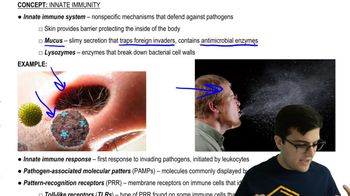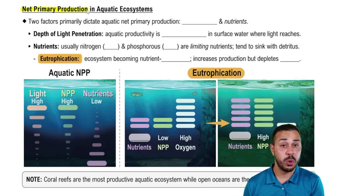Table of contents
- 1. Introduction to Biology2h 42m
- 2. Chemistry3h 40m
- 3. Water1h 26m
- 4. Biomolecules2h 23m
- 5. Cell Components2h 26m
- 6. The Membrane2h 31m
- 7. Energy and Metabolism2h 0m
- 8. Respiration2h 40m
- 9. Photosynthesis2h 49m
- 10. Cell Signaling59m
- 11. Cell Division2h 47m
- 12. Meiosis2h 0m
- 13. Mendelian Genetics4h 44m
- Introduction to Mendel's Experiments7m
- Genotype vs. Phenotype17m
- Punnett Squares13m
- Mendel's Experiments26m
- Mendel's Laws18m
- Monohybrid Crosses19m
- Test Crosses14m
- Dihybrid Crosses20m
- Punnett Square Probability26m
- Incomplete Dominance vs. Codominance20m
- Epistasis7m
- Non-Mendelian Genetics12m
- Pedigrees6m
- Autosomal Inheritance21m
- Sex-Linked Inheritance43m
- X-Inactivation9m
- 14. DNA Synthesis2h 27m
- 15. Gene Expression3h 20m
- 16. Regulation of Expression3h 31m
- Introduction to Regulation of Gene Expression13m
- Prokaryotic Gene Regulation via Operons27m
- The Lac Operon21m
- Glucose's Impact on Lac Operon25m
- The Trp Operon20m
- Review of the Lac Operon & Trp Operon11m
- Introduction to Eukaryotic Gene Regulation9m
- Eukaryotic Chromatin Modifications16m
- Eukaryotic Transcriptional Control22m
- Eukaryotic Post-Transcriptional Regulation28m
- Eukaryotic Post-Translational Regulation13m
- 17. Viruses37m
- 18. Biotechnology2h 58m
- 19. Genomics17m
- 20. Development1h 5m
- 21. Evolution3h 1m
- 22. Evolution of Populations3h 52m
- 23. Speciation1h 37m
- 24. History of Life on Earth2h 6m
- 25. Phylogeny2h 31m
- 26. Prokaryotes4h 59m
- 27. Protists1h 12m
- 28. Plants1h 22m
- 29. Fungi36m
- 30. Overview of Animals34m
- 31. Invertebrates1h 2m
- 32. Vertebrates50m
- 33. Plant Anatomy1h 3m
- 34. Vascular Plant Transport1h 2m
- 35. Soil37m
- 36. Plant Reproduction47m
- 37. Plant Sensation and Response1h 9m
- 38. Animal Form and Function1h 19m
- 39. Digestive System1h 10m
- 40. Circulatory System1h 57m
- 41. Immune System1h 12m
- 42. Osmoregulation and Excretion50m
- 43. Endocrine System1h 4m
- 44. Animal Reproduction1h 2m
- 45. Nervous System1h 55m
- 46. Sensory Systems46m
- 47. Muscle Systems23m
- 48. Ecology3h 11m
- Introduction to Ecology20m
- Biogeography14m
- Earth's Climate Patterns50m
- Introduction to Terrestrial Biomes10m
- Terrestrial Biomes: Near Equator13m
- Terrestrial Biomes: Temperate Regions10m
- Terrestrial Biomes: Northern Regions15m
- Introduction to Aquatic Biomes27m
- Freshwater Aquatic Biomes14m
- Marine Aquatic Biomes13m
- 49. Animal Behavior28m
- 50. Population Ecology3h 41m
- Introduction to Population Ecology28m
- Population Sampling Methods23m
- Life History12m
- Population Demography17m
- Factors Limiting Population Growth14m
- Introduction to Population Growth Models22m
- Linear Population Growth6m
- Exponential Population Growth29m
- Logistic Population Growth32m
- r/K Selection10m
- The Human Population22m
- 51. Community Ecology2h 46m
- Introduction to Community Ecology2m
- Introduction to Community Interactions9m
- Community Interactions: Competition (-/-)38m
- Community Interactions: Exploitation (+/-)23m
- Community Interactions: Mutualism (+/+) & Commensalism (+/0)9m
- Community Structure35m
- Community Dynamics26m
- Geographic Impact on Communities21m
- 52. Ecosystems2h 36m
- 53. Conservation Biology24m
41. Immune System
Innate Immunity
Problem 2`
Textbook Question
The overall role of the inflammatory response is to
a. Contain and eliminate foreign cells and material at the site of infection.
b. Increase heat at the site of infection to activate enzymes used in the immune response.
c. Produce antibodies that bind to and eliminate invading cells.
d. Increase blood flow at the site of a wound to flush out invading pathogens.
 Verified step by step guidance
Verified step by step guidance1
Understand the purpose of the inflammatory response: It is a part of the body's immune system designed to protect against infection and injury.
Identify the key components of the inflammatory response: These include increased blood flow, increased permeability of blood vessels, and the migration of white blood cells to the affected area.
Consider the role of increased blood flow: This helps deliver immune cells to the site of infection and can also help remove debris and pathogens.
Evaluate the role of heat: While heat can be a byproduct of increased blood flow and metabolic activity, the primary goal is not to activate enzymes but to support immune cell function.
Recognize that antibody production is a function of the adaptive immune response, not the immediate inflammatory response, which focuses on containing and eliminating foreign material.
 Verified video answer for a similar problem:
Verified video answer for a similar problem:This video solution was recommended by our tutors as helpful for the problem above
Video duration:
2mPlay a video:
Was this helpful?
Key Concepts
Here are the essential concepts you must grasp in order to answer the question correctly.
Inflammatory Response
The inflammatory response is a biological process triggered by the immune system to protect the body from harmful stimuli, such as pathogens or damaged cells. It involves the activation of immune cells, release of cytokines, and increased blood flow to the affected area, aiming to contain and eliminate foreign invaders and promote healing.
Recommended video:
Guided course

Inflammatory Response
Role of Heat in Immune Response
Heat generated during inflammation can enhance the immune response by increasing the activity of enzymes and immune cells. Elevated temperatures can inhibit the growth of pathogens and improve the efficiency of immune reactions, aiding in the containment and elimination of infections.
Recommended video:
Guided course

Innate Immune Response
Antibody Production
Antibodies are proteins produced by B cells in response to antigens. They specifically bind to foreign invaders, marking them for destruction by other immune cells. While antibody production is crucial for adaptive immunity, it is not a direct function of the inflammatory response, which primarily involves innate immune mechanisms.
Recommended video:
Guided course

Primary Production in Aquatic Ecosystems

 5:20m
5:20mWatch next
Master Innate Immune Response with a bite sized video explanation from Jason
Start learningRelated Videos
Related Practice









